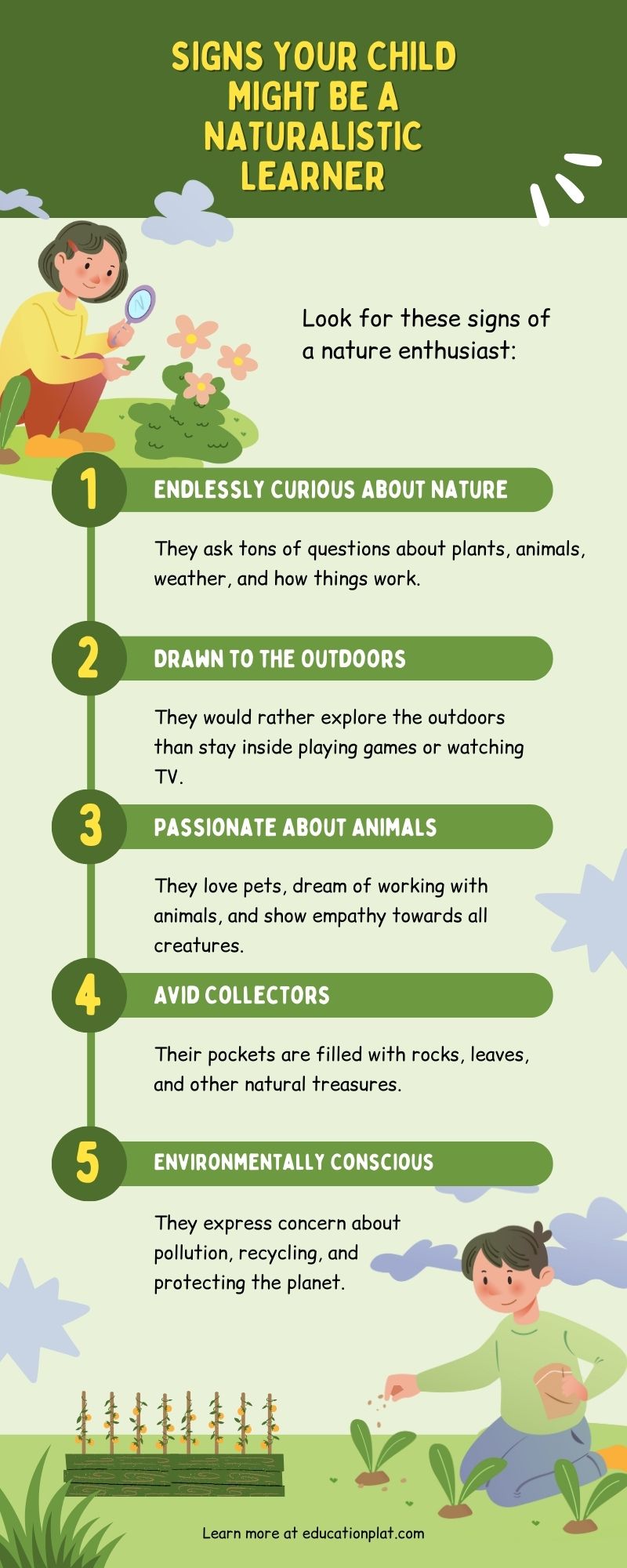Have you noticed your child’s eyes light up when they find a ladybug, or their endless questions about why leaves change color? These are signs of a naturalistic learner – someone with a deep connection to the natural world. Understanding naturalistic learners is crucial for parents and educators who want to foster their love of learning and their connection to the environment. By recognizing the unique traits and needs of this learning style, we can empower these young explorers to thrive.

Unlocking the Power of the Naturalistic Learning Style
Howard Gardner’s theory of Multiple Intelligences recognizes eight different ways people learn, and nurturing the naturalistic type offers multiple benefits:
- Environmental Responsibility: It fosters a deep love and understanding of the natural world, potentially inspiring future scientists, conservationists, and eco-advocates.
- Scientific Exploration: Naturalistic activities fuel a desire to understand how things work, sparking future researchers and problem-solvers.
- Well-Rounded Development: Supporting every learning style lets children explore their full potential and see the world from various viewpoints.
Cultivating a Love of Learning in the Natural World
Now that we’ve identified key characteristics of naturalistic learners, let’s explore practical strategies to empower their love of learning:
- Embrace Outdoor Learning: Whenever possible, take lessons outdoors! Science experiments in the schoolyard, history lessons at a local historical site, or book discussions under a shady tree can all be enriching experiences.
- Incorporate Nature into Indoor Learning: If access to the outdoors is limited, bring nature indoors! Display nature documentaries, create a classroom terrarium, or use natural objects like pinecones or seashells for counting or sorting activities.
- Project-Based Learning: Encourage projects that allow students to explore their interests in nature. This could involve building a bird feeder, researching endangered species, or creating a nature journal filled with observations and sketches.
- Problem-Solving Activities: Naturalistic learners thrive on problem-solving. Present real-world environmental challenges, like water pollution or deforestation, and encourage them to brainstorm solutions.
- Citizen Science Participation: Many organizations offer citizen science projects suitable for students of all ages. These initiatives allow them to contribute to real scientific research while exploring the natural world.
Educational Games and Activities
Learning doesn’t have to be confined to textbooks! Here are some engaging activities that cater to the strengths of naturalistic learners:
- Nature Scavenger Hunts: Create a list of natural objects to find, like different types of leaves, specific bird species, or colorful insects.
- Nature Bingo: Design bingo cards with squares featuring pictures or descriptions of natural elements. The first student to complete a row or bingo wins!
- Plant and Animal Identification Games: There are many apps and field guides available to help learners identify plants and animals they encounter in nature. Turn it into a fun game by timing each other or keeping a log of discoveries.
- Simulations and Roleplays: Encourage students to roleplay as different elements of an ecosystem, like trees competing for sunlight or animals adapting to changing weather patterns.
Encouraging Curiosity and Exploration at Home
Parents can nurture their child’s naturalistic tendencies by:
- Frequent Family Nature Outings: Explore hiking trails, visit parks, or simply spend time in your backyard observing wildlife.
- Gardening Together: Plant a vegetable garden or a butterfly garden. This teaches responsibility, patience, and allows children to witness the wonders of plant growth.
- Nature Documentaries and Books: Spark curiosity with age-appropriate documentaries about animals and ecosystems. Provide books and field guides to fuel their desire to learn more.
- Citizen Science Projects at Home: Many citizen science projects involve observations that can be done in your own backyard or neighborhood.
By fostering a connection with nature and providing stimulating learning experiences, we can empower naturalistic learners to thrive and develop a lifelong love of exploration and discovery.
Integrating Nature into the Classroom
While the advantages of incorporating naturalistic learning activities are clear, there are also practical considerations for educators:
- Curriculum Alignment: Finding ways to connect nature-based learning with established curriculum standards can be a challenge. However, with creativity and planning, educators can weave in valuable scientific concepts, critical thinking skills, and environmental awareness through these activities.
- Limited Resources: Access to outdoor spaces, field trip funding, and nature-themed educational materials can be limited. However, resourceful educators can leverage technology (virtual tours), community partnerships (local parks), and even small schoolyard gardens to create engaging experiences.
- Time Constraints: Fitting in additional activities within a packed school day can be challenging. However, even short nature walks or incorporating nature journaling during breaks can benefit naturalistic learners.
Overcoming Challenges and Embracing the Benefits
Despite these challenges, the benefits of integrating nature into the classroom are significant:
- Enhanced Learning: Naturalistic learners become more engaged and motivated when lessons connect to their inherent curiosity about the natural world.
- Improved Academic Performance: Studies show that students who participate in outdoor learning activities demonstrate better academic performance across various subjects.
- Development of Essential Skills: Naturalistic learning fosters critical thinking, problem-solving, collaboration, and observation skills – all crucial for success in school and beyond.
- Environmental Stewardship: By fostering a connection with nature, educators can nurture a generation of environmentally conscious citizens.
FAQs
Wrapping Up
Understanding and nurturing naturalistic learners is a valuable investment. By fostering their connection with the natural world, we unlock their curiosity, problem-solving skills, and sense of environmental responsibility. Whether children dream of becoming scientists, eco-advocates, or simply want to experience the enriching wonders of nature, supporting their naturalistic intelligence helps them to grow into well-rounded individuals.
